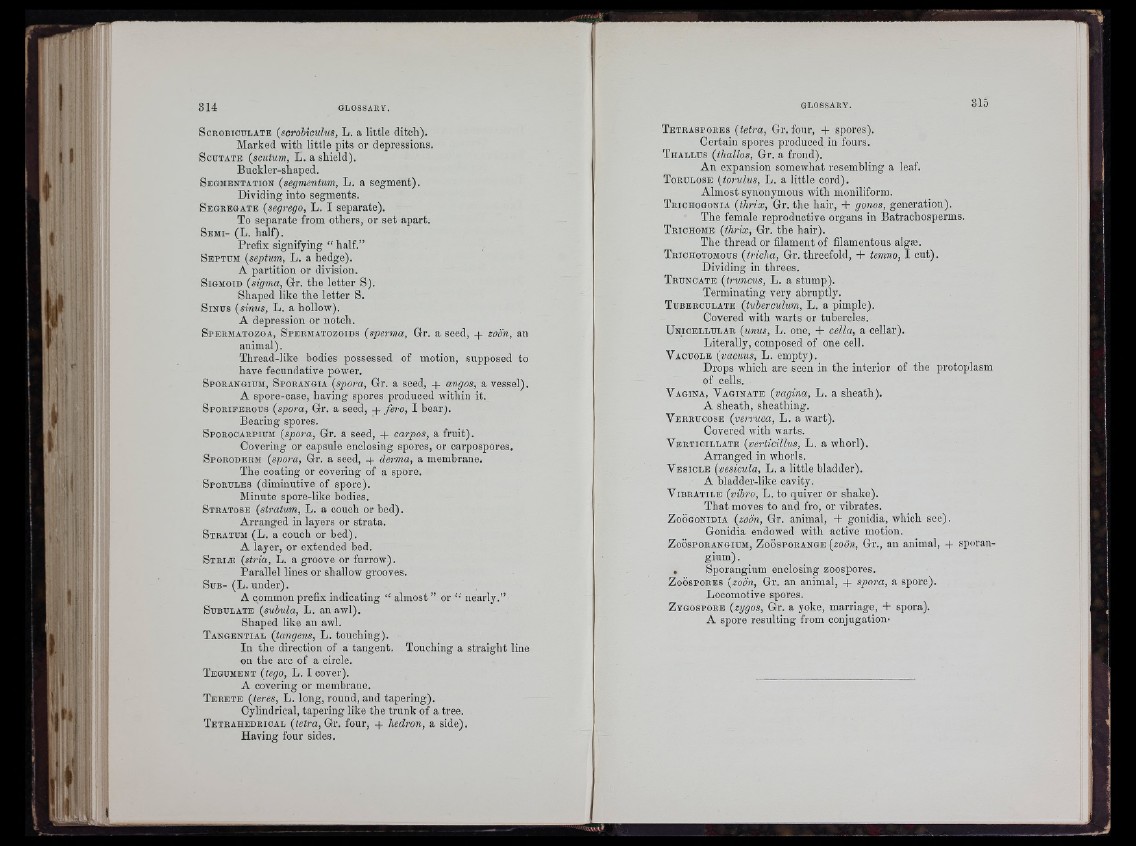
k
S crobicdlatb (scrobicuhts, L. a little d itch).
Marked with little pits or depressions.
S cutate {scutum, L. a shie ld).
Buckler-shaped.
Segmentation (segmentum, L. a se gm en t).
Dividing into segments.
S egregate (segrego, L. I separate).
To separate from others, or set apart.
Semi- (L. h a lf).
Prefix signifying “ half.”
S eptum {septum, L. a hedge).
A partition or division.
S igmoid {sigma, Gr. the letter S).
Shaped like the letter S.
S inus {sinus, L. a hollow).
A depression or notch.
Spermatozoa, S permatozoids (sperma, Gr. a seed, + zom, an
an im a l).
Thread-like bodies possessed of motion, supposed to
have fecundative power.
Sporangium, Sporangia {spora, Gr. a seed, + angos, a vessel).
A spore-oase, having spores produced within it.
S poriferous (spora, Gr. a seed, + fero, I bear).
Bearing spores.
S porooaepium (spora, Gr. a seed, + carpos, a fruit).
Covering or capsule enclosing spores, or carpospores.
Sporoderm (spora, Gr. a seed, + derma, a membrane.
The coating or covering of a spore.
Sporules (diminutive of spore).
Minute spore-like bodies.
Stratose (stratum, L. a couch or bed).
Arranged in layers or strata.
S tratum (L. a couch or bed ).
A layer, or extended bed.
S tr iæ (stria, L. a groove or furrow).
Parallel lines or shallow grooves.
Sub- (L. under).
A common prefix indicating “ almost ” or “ nearly.”
Subulate (suhula, L. an awl).
Shaped like an awl.
T angential (tangens, L. to u ch in g ).
In the direction of a tangent. Touching a straight line
on the arc of a circle.
T egument (tego, L. I cover).
A covering or membrane.
T er e te (teres, L. long, round, and tapering).
Cylindrical, tapering like the trunk of a tree.
Tetrahedrical (tetra, Gï. four, -f hedron, a side).
Having four sides.
h i '
T etraspores (tetra, Gr. fonr, -f spores).
Certain spores produced in fours.
T hallus (thallos, Gr. a frond).
An expansion somewhat resembling a leaf.
T orulose [torulus, L. a little cord).
Almost synonymous with moniliform.
T richogonia (thrix, Gr. the hair, -f gonos, generation).
The female reproductive organs in Batrachosperms.
T richome (thrix, Gr. the hair).
Tbe thread or filament of filamentous algaj.
T eichotomous (tricha, Gr. threefold, -1- ternno,! cut).
Dividing in threes.
T runcate (truncus, L. a stump).
Terminating very abruptly.
T uberculate (tuberculum, L. a pimple).
Covered with warts or tubercles.
U nicellular (unus, L. one, -|- cella, a cellar).
Literally, composed of one cell.
V acuole (vacuus, L. empty).
Drops which are seen in the interior of the protoplasm
of cells.
V agina, V aginate (vagina, L. a sheath).
A sheath, sheathing.
V errucose (verruca, L. a wart).
Covered with warts.
V erticillate (verticillus, L. a whorl).
Arranged in whorls.
V es icle [vesicula, L. a little bladder).
A bladder-like cavity.
V ibratile (vibro, L. to quiver or shake).
That moves to and fro, or vibrates.
Z oogonidia (zoon, Gr. animal, + gonidia, which see).
Gonidia endowed with active motion.
Z oosporangium, Z oosporange (zoon, Gr., an animal, g- sporangium).
, Sporangium enclosing zoospores.
Z oospores (zoon, Gr. an animal, + spora, a spore).
Locomotive spores.
Z ygospore (zygos, Gr. a yoke, marriage, + spora).
A spore resulting from conjugation